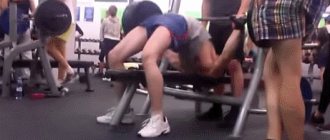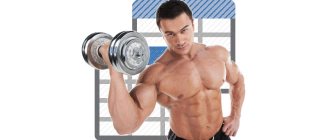Hello friends! Vitaly Okhrimenko is on the line. Remember I wrote about warming up before training in the gym? So, every workout should begin with a warm-up. How should it end? - you ask. That's right, it should end with a hitch.
After all, the cool-down after training, which we will talk about today, is the missing puzzle that will help us swing correctly and get the most out of our workout. And at the same time it will help get rid of this unpleasant muscle pain the next day after training. Well, okay, I won’t get ahead of myself, let’s talk about everything in order.
Why do you need a cool down?
The vast majority of us (gym goers) never cool down after a workout. Apparently we consider this a waste of time: why bother, the main work has already been done. But no, dear blog readers and fans of the hall. Here we are deeply mistaken: a cool-down should be as integral a part of training as a shower after training
. Now I will explain why this is so, and below I will describe the cool-down exercises.
Any workout in the gym is accompanied by the following characteristics: body temperature increases, heart rate increases, blood is filled with oxygen and is more concentrated in the muscles being trained. In fact, it is always stressful for our body, even moreover, we must try to ensure that every workout with weights is stressful for the body. I wrote about this in detail in the article on how to build a workout in the gym.
This is all good and correct, but all this has one side effect: the blood remains in the trained muscles and stagnates. The body is not able to quickly adapt from a critical pace of life to a normal one. This can be compared to the fact that we will run at fast speed and then suddenly stop. What will happen? By inertia, our body will fly forward, the body will remain in a state of fast speed for some time with all that it implies.
A sharp transition from the “active” state to the “calm” state has a bad effect on our health!
As a result, we get an inadequately high load on the heart, and other organs do not receive the required amount of blood after training for a long time. This is where we need a hitch. This is kind of like a signal to our body: “STOP! That’s it, there will be no more harshness, you can relax.” The central nervous system (CNS) apparatus responds perfectly to this signal.
However, we have looked at the benefits of a cool-down for our health. But there are also benefits to the muscles of a cool-down.
The cool-down must include stretching of the muscles being trained (stretching). This allows us to return the muscles to their original length. Damn, I wanted to keep it short, but apparently it won’t work.
The effect of warming up on the body and psyche
Here's what happens to the body during warm-up:
– Cardiovascular system: during warm-up, your heart rate increases and more blood begins to circulate throughout your body. This way the muscles are better supplied with oxygen and nutrients.
– Blood pressure: Blood pressure increases. Blood begins to flow faster through the vessels and thereby better supplies the muscles with nutrients.
– Breathing: breathing becomes more frequent, thus increasing pulmonary ventilation and meeting the growing need for oxygen.
– Nervous system: neuromuscular communication improves, thereby reducing energy requirements, the central nervous system gets tired more slowly, and reaction speed increases.
– Body temperature: during a good warm-up, body temperature rises to 38.5 – 39 degrees Celsius. Under such conditions, physiological reactions occur most efficiently.
– Joints and ligaments: the body produces more joint fluid, thereby increasing the volume of articular cartilage. In this way, the pressure exerted on the articular cartilage can be more easily tolerated. Ligaments and tendons become more elastic due to increased temperature.
– Muscles: muscles fill with blood, become stronger and less susceptible to damage.
– Mental: Warm-up increases concentration and perception. Increased concentration helps to cope with sudden critical situations during training or competition (for example, some kind of obstacle). An optimal warm-up also increases motivation for upcoming physical activity, reduces stiffness and reduces nervousness.
The benefits of cool-downs for muscles
During exercise, our muscles contract. To increase in volume, muscles have to sacrifice their length (very, very simplified).
As you know, muscle growth begins only after the muscle is restored. It turns out that before our body returns the muscle to its former length, the process of muscle growth will not begin.
.
What will happen if we train muscles faster than they have time to restore length? That's right, the muscles will remain in a contracted form. To begin with, this will cause unusual inconvenience to our musculoskeletal system, because the joints are designed for one length of muscle fibers, and we will voluntarily reduce this length with training without a hitch and stretching. As a result, we become less mobile (like koalas in a fleshy shell) and create additional stress on our joints. Which, by the way, training with weights doesn’t bring anything good anyway. This can be compared to wearing a suit a couple sizes smaller.
It’s a completely different matter when our muscles undergo a systematic cool-down after training with stretching elements. Muscles recover much faster and therefore begin to grow earlier . The flexibility of both muscle tissue and joint joints increases. We can do the exercise with a greater amplitude, which means we can load the muscles better, and as a result, get a better athletic result. In addition, thanks to the cool-down, blood circulation improves , the trained muscles receive more oxygen through the blood, and this, of course, has a positive effect on muscle growth. Normalization of blood supply supplies our muscles with an increased amount of nutrients .
In addition to all the above advantages, it should be noted that due to the fact that the muscle becomes longer, its growth potential certainly increases. After all, there is more room for growth! I wrote about all this in more detail here.
Well, to all of the above, you should also add the removal of lactic acid from the muscles through a cool-down. This very acid makes our muscles ache the day after training. After all, you and I are familiar with these sensations: muscle aches, decreased joint mobility. It feels like the muscle is simply being squeezed from the inside, and any hint of stretching brings not the most pleasant feelings. I assure you, if you systematically do a cool-down after training, you will soon forget about this trouble.
From the entire text above, I propose to summarize the goals for which we need to do a cool-down after training in the gym.
What is a cool down
Perhaps I’m wrong and this is where I should have started today’s article. However, I decided to start with the benefits of a hitch, for which you have the right to judge me)). So, having figured out why we need a cool-down after strength training, it’s time to understand what a cool-down actually is.
A cool-down is an exercise performed at the end of a workout at a slow and easy pace, which allows the body to move from an excited state to a calm or close to calm state (source bodykeeper.ru).
The cool-down primarily includes stretching and cardio exercises. Stretching restores muscles to their former length and elasticity, and at the same time reduces the recovery process. Cardio exercise prepares our nervous system and our muscles for rest.
Strength and speed training
Basketball values powerful movements—executed in an explosive, fast manner. That's why speed-strength training is the most favorite among professional athletes.
One of the most effective exercises in this category is the one-arm dumbbell snatch:
- Place your feet hip-width apart.
- Take the dumbbell in your right hand and lower it in front of you.
- Bend over quickly, lowering the dumbbell just below knee level.
- Powerfully straighten your body, move your pelvis forward, and “squeeze” your shoulder from the side of your working leg.
- Throw the dumbbell up and, sitting down in time, catch it with your straight hand.
- The exercise is repeated four times on each hand in three approaches.
How to properly cool down after a workout
The first 5 minutes of the cool-down should be devoted to cardio. For example, running or riding an exercise bike. And there is a trick here:
Cardio cool-down should start at a faster pace and end at a slower pace.
We start, for example, by running at a moderate pace and within 5 minutes we move from a leisurely run to a slow walk, after which we begin stretching. The purpose of sedative cardio is to normalize heart contractions, bringing the pulse to a state close to resting. This trick indicates to the nervous system mentioned above that we will no longer abuse the body and we can finally relax
.
After the calming cardio, you need to do some stretching exercises. Moreover, you only need to stretch those muscles that were trained. As an example, follow the link above and see which exercises for which muscles. Performing each exercise once for 30 to 60 seconds each workout is more than enough for a good stretch during the cool-down.
As a rule, several muscle groups are worked out during training. Each one needs to be stretched accordingly.
On average, during 1 workout, 5 stretching exercises are done as a cool-down, which takes an average of 5 minutes. Stretching is done carefully; there should be no pain. Light static stretches without jerking or rocking. This is written in detail in the article on how to stretch and why jocks should stretch.
In general, you should not spend more than 10 minutes on a cool down. The purpose of a cool-down is to calm the body, and not completely exhaust it.
Cooldown and potential harm to recovery
Physiologist Dave Costill of Ball State University says that in many cases, an active cool-down can harm the recovery process and reduce performance in subsequent training or competitions6.
Together with his Swedish colleague Bengt Saltin, he discovered that up to 75 percent of the glycogen used up during a strenuous workout can be restored quite quickly in the leg muscles if runners rest rather than jog after the workout is completed7.
Because high-intensity training requires sufficient muscle glycogen reserves, scientists have concluded that long cool-downs should be avoided when heavy or long training sessions are performed over several days in a row.
However, how does this compare to the Reilly study, which claimed that cooling down promotes recovery? First, in those cases, the cool-down consisted of only 5 minutes of jogging, which is not enough to significantly affect muscle glycogen stores. Secondly, stretching may have had a positive effect, since it does not require the use of precious glycogen reserves; Some studies have also shown that stretching improves intramuscular glycogen synthesis.
Cool-down exercises
Well, now we get to the most interesting part. As I wrote above, we conditionally divide the cool-down into two stages.
Cardio cool-down
At this stage, you need to choose any cardio exercise and do it according to the principle from faster to slower. Our task, as I wrote above, is to normalize the pulse. By the end of an intense workout, our heart rate usually approaches twice or even more than our resting heart rate. Cardio cool-down allows us to smoothly reduce the rhythm of the heartbeat, which will not cause stress to the body.
Perfect for cardio warm-up:
- Jogging, turning into slow walking.
- Exercise bike, elliptical trainer, orbit track.
- Jumping rope with a decrease in tempo.
- Sparring with a punching bag - from fast to slow.
Cooldown and cardiac arrhythmia
Failure to cool down properly can increase your chance of experiencing a potentially dangerous condition called cardiac arrhythmia. However, studies have shown that after an intense workout, it's perfectly acceptable to jog or just lie on your back after an intense workout!
The real problem can arise if a runner decides to just stand after completing a workout. During heavy physical activity, the concentration of norepinephrine in the blood increases significantly. This hormone is an important regulator of blood pressure and also causes an increase in cardiac output.
Norepinephrine levels may rise critically after completing an intense workout to prevent a rapid drop in blood pressure. Unfortunately, high concentrations of norepinephrine are associated with an increased risk of irregular heartbeat. Standing still after a hard workout is a bad idea because it causes your blood pressure to plummet (meaning your leg muscles stop pushing blood up toward your heart). This releases more norepinephrine to increase blood pressure and therefore increases the likelihood of arrhythmia.
In contrast, jogging, walking, or lying on your back during a cool-down helps stabilize blood pressure: running and walking keep your heart rate naturally and keep blood flowing to your leg muscles, and lying down allows blood to flow back to your heart more easily because she doesn't need to go up. As a result, less norepinephrine is released and the risk of arrhythmia is reduced8.











